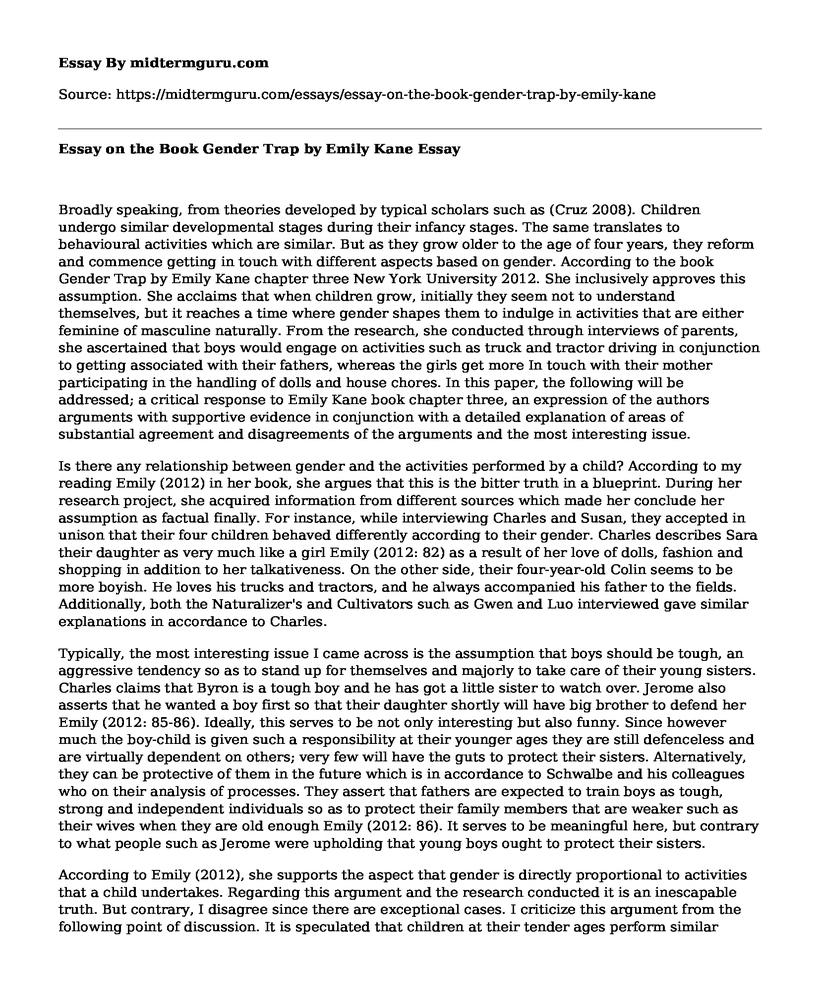Broadly speaking, from theories developed by typical scholars such as (Cruz 2008). Children undergo similar developmental stages during their infancy stages. The same translates to behavioural activities which are similar. But as they grow older to the age of four years, they reform and commence getting in touch with different aspects based on gender. According to the book Gender Trap by Emily Kane chapter three New York University 2012. She inclusively approves this assumption. She acclaims that when children grow, initially they seem not to understand themselves, but it reaches a time where gender shapes them to indulge in activities that are either feminine of masculine naturally. From the research, she conducted through interviews of parents, she ascertained that boys would engage on activities such as truck and tractor driving in conjunction to getting associated with their fathers, whereas the girls get more In touch with their mother participating in the handling of dolls and house chores. In this paper, the following will be addressed; a critical response to Emily Kane book chapter three, an expression of the authors arguments with supportive evidence in conjunction with a detailed explanation of areas of substantial agreement and disagreements of the arguments and the most interesting issue.
Is there any relationship between gender and the activities performed by a child? According to my reading Emily (2012) in her book, she argues that this is the bitter truth in a blueprint. During her research project, she acquired information from different sources which made her conclude her assumption as factual finally. For instance, while interviewing Charles and Susan, they accepted in unison that their four children behaved differently according to their gender. Charles describes Sara their daughter as very much like a girl Emily (2012: 82) as a result of her love of dolls, fashion and shopping in addition to her talkativeness. On the other side, their four-year-old Colin seems to be more boyish. He loves his trucks and tractors, and he always accompanied his father to the fields. Additionally, both the Naturalizer's and Cultivators such as Gwen and Luo interviewed gave similar explanations in accordance to Charles.
Typically, the most interesting issue I came across is the assumption that boys should be tough, an aggressive tendency so as to stand up for themselves and majorly to take care of their young sisters. Charles claims that Byron is a tough boy and he has got a little sister to watch over. Jerome also asserts that he wanted a boy first so that their daughter shortly will have big brother to defend her Emily (2012: 85-86). Ideally, this serves to be not only interesting but also funny. Since however much the boy-child is given such a responsibility at their younger ages they are still defenceless and are virtually dependent on others; very few will have the guts to protect their sisters. Alternatively, they can be protective of them in the future which is in accordance to Schwalbe and his colleagues who on their analysis of processes. They assert that fathers are expected to train boys as tough, strong and independent individuals so as to protect their family members that are weaker such as their wives when they are old enough Emily (2012: 86). It serves to be meaningful here, but contrary to what people such as Jerome were upholding that young boys ought to protect their sisters.
According to Emily (2012), she supports the aspect that gender is directly proportional to activities that a child undertakes. Regarding this argument and the research conducted it is an inescapable truth. But contrary, I disagree since there are exceptional cases. I criticize this argument from the following point of discussion. It is speculated that children at their tender ages perform similar activities, but from the age of four years, they drastically reform and begin indulging in gender-based activities. Yes, this sounds to be true. But some children never change, for instance, some boys' proceeds being girlish until adulthood translating the same to girls. This maybe as a result of the following; when a boy is raised by the mother alone and vice versa, when a boy is raised in the midst of several girls and vice versa. Others naturally dont reform entirely. Therefore, they remain the same until adulthood without any impact of gender shaping their lives.
References
Cruz Braves .2008. Human Development assessment trough the human-scale develoment approach: Integrating different perspectives in the contribution to a Sustainable Human Development Theory. Madrid: Entimema.
Emily Kane 2012.The Gender Trap. New York University. pp. 82-110.
Cite this page
Essay on the Book Gender Trap by Emily Kane. (2021, Jun 04). Retrieved from https://midtermguru.com/essays/essay-on-the-book-gender-trap-by-emily-kane
If you are the original author of this essay and no longer wish to have it published on the midtermguru.com website, please click below to request its removal:
- Emotional Intelligence Effects on a Students Career Employability
- Trauma Informed Parents: Analysis of the Website
- Case Study Analysis Paper Example on Borderline Personality Disorder
- Article Analysis Essay on Child Sex Abuse
- Research Paper on Bipolar Disorder
- Jose Depression - Case Study
- Operant Conditioning: How It Can Shape Human Behavior - Essay Sample







